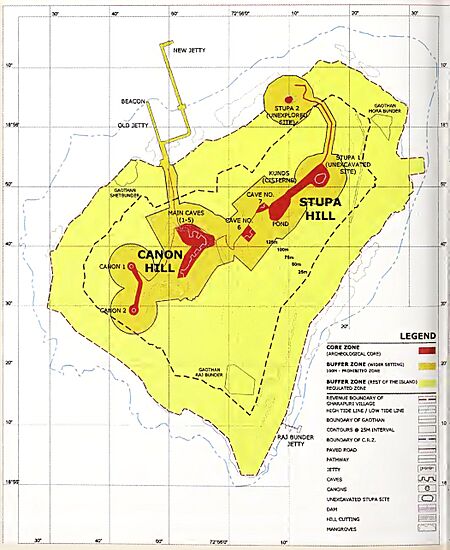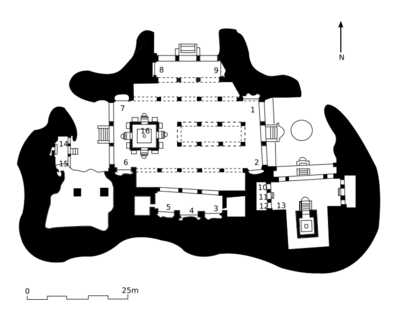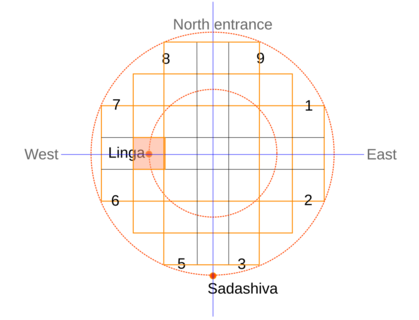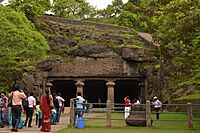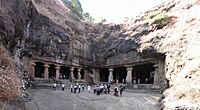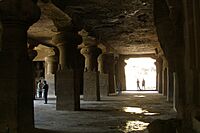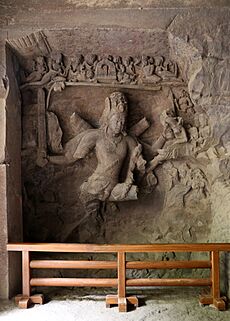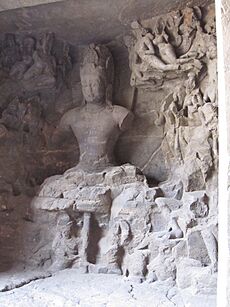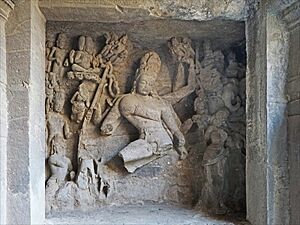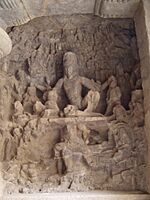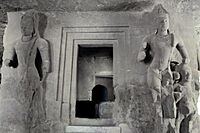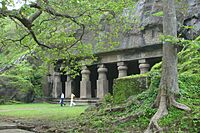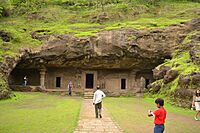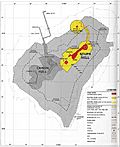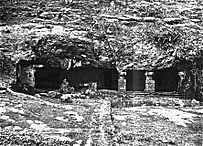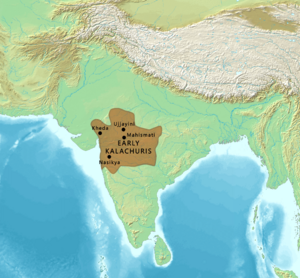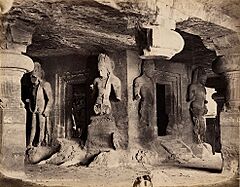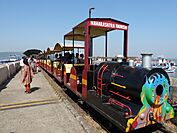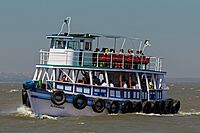Elephanta Caves facts for kids
Quick facts for kids UNESCO World Heritage Site |
|
|---|---|
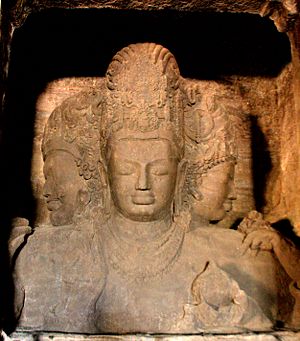
The 7 metres (23 ft) high Trimurti sculpture
|
|
| Location | Elephanta Island, Maharashtra, India |
| Criteria | Cultural: i, iii |
| Inscription | 1987 (11th Session) |
The Elephanta Caves are a group of ancient cave temples. They are mostly dedicated to the Hindu god Shiva. These caves are so special that UNESCO has named them a World Heritage Site. You can find them on Elephanta Island, also known as Gharapuri. This name means "the city of caves." The island is in Mumbai Harbour, about 10 kilometres (6.2 mi) east of Mumbai in the Indian state of Mahārāshtra.
Elephanta Island has five main Hindu caves. It also has some Buddhist stupa mounds from the 2nd century BCE. There are also two Buddhist caves with water tanks. The caves are carved right out of solid basalt rock. They feature amazing stone sculptures, mostly in high relief. These artworks mix ideas from both Hindu and Buddhist beliefs.
Sadly, much of the artwork is damaged. But the most famous carvings are the huge 5.45 metres (17.9 ft) tall Trimurti Sadashiva (Shiva with three faces), Nataraja (Shiva as the Lord of Dance), and Yogishvara (Shiva as the Lord of Yogis). Experts believe these caves were built between the 5th and 9th centuries. Many think they were finished around 550 CE.
The Portuguese explorers named the island Elefante (which became Elephanta). They found large elephant statues on the island. The main cave (Cave 1) was a Hindu worship place until the Portuguese arrived. Later, in the 1970s, the monuments were restored. Today, the Archaeological Survey of India (ASI) takes care of them.
Contents
- Exploring Elephanta Island
- What You'll See: The Caves
- Cave 1: The Great Cave
- Sadashiva: The Three-Faced Shiva
- Gangadhara: Shiva and the Ganges River
- Ardhanarishvara: Half-Man, Half-Woman Shiva
- Shiva Slaying Andhaka: The Demon Slayer
- Wedding of Shiva: Kalyanasundara
- Yogishvara: Lord of Yoga
- Nataraja: Lord of Dance
- Mount Kailash and Ravananugraha
- Linga Shrine: The Heart of the Cave
- East Wing: The Seven Mothers
- West Wing: Other Artworks
- Caves 2-5: Smaller Caves
- Stupa Hill: Buddhist Caves and Stupas
- Cave 1: The Great Cave
- Lost Artworks
- History of the Caves
- Protecting the Caves
- In Books and Stories
- See also
Exploring Elephanta Island
Elephanta Island, or Gharapuri, is about 11 km (6.8 mi) east of the Gateway of India in Mumbai. It's a short ferry ride away. The island covers about 10 km2 (3.9 sq mi) at high tide. Gharapuri is a small village on the island's south side.
You can reach the Elephanta Caves by ferry from the Gateway of India, Mumbai. Ferries run daily between 9 AM and 2 PM, except on Mondays when the caves are closed. Mumbai has a big airport and is connected by train.
The island is 2.4 km (1.5 mi) long. It has two hills that rise to about 150 m (490 ft) high. A narrow valley separates the two hills. The hills are covered with trees like mango and tamarind. The shoreline has sand, mud, and mangrove bushes.
There are five rock-cut caves on the western hill. There is also a brick stupa on the eastern hill. The eastern hill has two Buddhist mounds and is called the Stupa hill. Caves 6 and 7 are on the eastern hill, close to the five western caves. The most popular and important cave is Cave 1, also known as the Great Cave. It's on the western hill, about a kilometer's walk up a steep path.
The Indian government declared a "prohibited area" around the island in 1985. This zone stretches 1 kilometre (0.62 mi) from the shoreline to protect the site.
What You'll See: The Caves
The island has two groups of caves carved from solid basalt rock. The larger group, with five caves, is on the western hill. These are famous for their Hindu sculptures. The main cave, Cave 1, is about 1.0 km (0.62 mi) up the hillside, facing Mumbai harbor. Caves 2 to 5 are near Cave 1. Caves 6 and 7 are on the eastern hill.
The two hills are connected by a walkway. The eastern hill is called Stupa hill because of its ancient Buddhist stupa. The western hill is called Canon hill because of old Portuguese cannons found there.
All the caves are rock-cut temples. They cover an area of 5,600 m2 (60,000 sq ft). Some caves have a main room, side rooms, courtyards, and smaller shrines. Cave 1 is the biggest, measuring 39 metres (128 ft) deep. The main temple is dedicated to Shiva. Its carvings tell stories and beliefs of Shaivism (the worship of Shiva). However, you can also see themes from Shaktism and Vaishnavism (other Hindu traditions).
Cave 1: The Great Cave
Cave 1, also called the Grand Cave or Great Cave, is a huge 39.63 metres (130.0 ft) square hall. Its design is similar to ancient Buddhist monasteries. The main entrance is small, hiding the grand hall inside. It faces north, which is unusual for a Shiva temple. But inside, the main Shiva shrine faces east, towards the sunrise.
What you'll find inside (3D tour available online):
- Ravananugraha
- Shiva-Parvati, Mount Kailash
- Ardhanarishvara
- Sadashiva Trimurti
- Gangadhara
- Wedding of Shiva
- Shiva slaying Andhaka
- Nataraja
- Yogishvara
- Linga (main shrine)
East Wing Shrine
- Kartikeya
- Matrikas
- Ganesha
- Dvarapala
West Wing Shrine
- Yogishvara
- Nataraja
To reach the main cave, you walk up 120 steep steps from the beach. Or you can take a tourist toy train. At the main entrance, there are four pillars. Inside, rows of pillars divide the hall into smaller areas. The roof has hidden beams supported by stone columns.
The temple is built inside the cave, so it has inner walls but no outer ones. The pillars create a sense of space and support the weight of the hill above. The main hall leads to a pillared entrance area.
Inside the Great Cave, there are special shrines. The largest is the square Linga shrine. This shrine has four entrances. Each entrance is guarded by two tall dvarapalas (gate guardians). These guardians were badly damaged by the Portuguese. Steps lead up to the inner sanctum, which holds a linga (a symbol of Shiva). The linga shrine has a path around it for pilgrims to walk.
The northern entrance has two damaged panels of Shiva. The left panel shows Yogishvara (Shiva as the Lord of Yoga). The right panel shows Nataraja (Shiva as the Lord of Dance). The central Sadashiva sculpture is flanked by two large carvings: one of Ardhanarishvara and one of Gangadhara. All the carvings tell stories from Shaivism.
Each wall has large carvings of Shiva legends, over 5 metres (16 ft) tall. The most important is the central Shiva relief called Trimurti. It's on the south wall, opposite the main entrance. Also called Sadashiva, it's a huge carving, over 6.27 metres (20.6 ft) tall. It shows four faces of Shiva.
Smaller shrines are at the east and west ends of the caves. The eastern shrine was a ceremonial entrance. It shows symbols from the Shaktism tradition (worship of the goddess Shakti).
Sadashiva: The Three-Faced Shiva
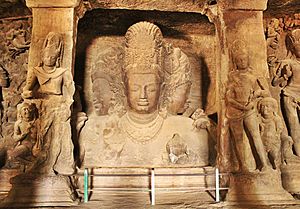
The Trimurti is considered the most important sculpture in the caves. It's carved on the south wall, facing the north entrance. It's also known as Sadashiva or Maheshmurti. This huge image, 7 m (23 ft) tall, shows Shiva with three heads.
The three heads represent Shiva's three main roles: creating, protecting, and destroying. Another idea is that they show compassion and wisdom. The right face (west) holds a lotus bud, symbolizing new life and creativity. This face represents Brahma, the creator, or Uma, Shiva's feminine side. The left face (east) is a young man with a mustache. This is Shiva as the scary Aghora or Bhairava, the destroyer. The central face is calm and meditating. It looks like the preserver Vishnu. This face shows Shiva as the "master of positive and negative things" and the one who keeps them balanced. These three faces show Shiva's different aspects in Shaivism. They also symbolize Shiva, Vishnu, and Brahma.
Gangadhara: Shiva and the Ganges River
The Trimurti Shiva is flanked by two other large carvings. On its left is Ardhanarisvara (half-Shiva, half-Parvati). On its right is the Gangadhara story. The Gangadhara image shows Shiva and Parvati standing. Shiva brings the Ganges River down from the heavens. He easily holds its huge power in his hair as it flows down. The artists carved a small three-bodied goddess high up. This symbolizes the Ganges, Yamuna, and Saraswati rivers. Mother goddess Parvati stands next to Shiva, smiling. The carving is 4 m (13 ft) wide and 5.207 m (17.08 ft) high.
The Gangadhara image is very damaged, especially Shiva's lower half. From Shiva's crown, a cup with a three-headed female figure (with broken arms) shows the three major rivers. Shiva is decorated with ornaments. Gods and goddesses gather to watch this amazing event. You can identify them by their vahana (vehicle) and symbols. They include Brahma, Indra, Vishnu, Saraswati, Indrani, and Lakshmi.
A coiling serpent, Shiva's symbol, is wrapped around one of his arms. Another hand (partly broken) looks like Shiva hugging Parvati. A damaged cloth covers his lower body. Parvati is carved to Shiva's left, with fancy hair and jewelry. Between them, a dwarf jester looks confused. He wonders if Shiva can really hold the mighty river goddess. At the bottom left, a kneeling figure in namaste posture represents King Bhagiratha. He worked hard to bring the river to his kingdom.
Ardhanarishvara: Half-Man, Half-Woman Shiva
On the wall to the east of the Trimurti is a damaged four-armed Ardhanarishvara carving. This image is 5.11 m (16.8 ft) tall. It shows the ancient Hindu idea that male and female parts are equally important in the universe. They are needed for creation, life, and destruction. It's shown as half-woman (Parvati) on the right side. She has feminine hair and holds a mirror. The other half is man (Shiva) with male features and symbols. In Shaivism, this image shows that spiritual existence has no differences, even gender. Energy (Shakti, Parvati) and soul (Brahman, Shiva) are united.
The carving shows a special headdress. The female side (Parvati) has jewelry, like armlets and rings. The male side (Shiva) has curly hair and a crescent moon. One of Shiva's hands rests on Nandi bull's horn. Nandi is Shiva's mount and is well preserved. The back hands are also jeweled. The male side's right hand holds a serpent. The female side's left hand holds a mirror. The front left hand is broken. Much of the lower part of the carving is damaged. Around the Ardhanarishwara, there are three layers of figures. At the bottom are human figures looking at the half-man, half-woman image. Above them are gods and goddesses like Brahma, Vishnu, and Indra, riding their vahanas. Even higher are flying apsaras bringing garlands and music.
Shiva Slaying Andhaka: The Demon Slayer
On the northwest side of the cave, near the west entrance, is a rare sculpture. It shows Bhairava, a fierce form of Shiva, killing the demon Andhaka (meaning "blind" or "darkness"). The lower part of the carving is very ruined. It is 3.5 m (11 ft) high and shows Shiva in action. Even though it's a carving, it looks three-dimensional, as if Shiva is coming out of the rock.
Bhairava's headgear has a skull and a cobra. His face shows anger and determination. His legs and five of his eight arms are broken. This damage is thought to be from Portuguese vandalism. The smaller, broken image of Andhaka is seen below Bhairava. One of Shiva's hands holds a bowl to catch the demon's blood. This was important because the blood could create new demons if it touched the ground. The artwork also shows ruined parts of other figures, including two female forms, two ascetics, and two dwarfs. At the top, flying apsaras bring garlands.
Wedding of Shiva: Kalyanasundara
The carving on the southwest wall, near the Linga shrine, shows the wedding of Shiva and Parvati. This story is called the Kalyanasundara. Parvati stands to Shiva's right, which is the traditional place for a Hindu bride. The carvings are very damaged. But what remains has helped experts study ancient Hindu stories. In many stories, the wedding happens in King Parvata's palace. But here, King Parvata stands behind Parvati, giving her away to Shiva. Brahma is the priest in this carving. Gods, goddesses, and heavenly apsaras are watching the wedding. Vishnu is also present, standing behind Brahma. Sages and other figures hang from the ceiling, blessing the wedding.
Shiva, the groom, looks calm and young. Parvati is shown as shy and emotional. Her head is tilted towards him, and her eyes are lowered. His hand (now broken) holds hers. Their clothes follow Hindu customs. Shiva wears the sacred thread across his chest. Parvati wears traditional jewelry. Other figures in the wedding hold items typical of a Hindu wedding. Chandra (the moon god) holds a decorated water pot. Brahma, the priest, sits on the floor, tending the yajna fire.
Yogishvara: Lord of Yoga
The panel on the east side of the entrance area shows Shiva in Yoga. This form of Shiva is called Yogishvara or Mahayogi.
In this carving, Shiva is the "first yogi". He is the master of discipline and the teacher of Yoga. He shows how yoga and meditation lead to understanding the ultimate truth.
The carving is in poor condition, with most arms and legs broken. Shiva is seated in the padmasana (lotus pose), deep in meditation. His posture is very clear. It shows that the 6th-century artist knew this yoga pose. He sits on a lotus flower that seems to grow from the earth. Two Nagas (snake deities) flank the lotus, showing their respect. Various gods, goddesses, monks, and holy men approach the great yogi. But a halo around him keeps them at a distance, as if they admire him but don't want to disturb his meditation.
The yogi artwork here is similar to what you find in Buddhist caves. But there are differences. Yogi Shiva wears a crown here. His chest is shown pushed forward, like in breathing exercises from Hindu yoga texts. His face and body show different energy. This Shiva yogi seems like the "lord of the caves."
Nataraja: Lord of Dance
The panel opposite the Yogishvara, on the west side of the entrance area, shows Shiva as the Nataraja. He is the "cosmic dancer" and "the lord of dancers." It's also called the Nrittamurti.
This badly damaged carving is 4 m (13 ft) wide and 3.4 m (11 ft) high. His body and arms are shown wildly moving in a dance pose. This symbolizes him filling all space with soaring energy and weightlessness. His face here looks like the Tatpurusha, the form of Shiva that preserves all creation. This Nataraja has eight arms. The parts that remain show him holding an axe. A coiled serpent is wrapped around its top. In another hand, he holds a folded cloth, possibly symbolizing maya (illusion).
There are fewer gods and observers in this panel than in others. Brahma, Vishnu, Lakshmi, Saraswati, and Parvati are visible. Their faces show they are amazed. His sons, Ganesha and Kartikeya, are also present. They are shown leaping, with Kartikeya holding Shiva's staff. An ascetic and a sage are also there. This carving combines family life and spiritual life through the metaphor of dance. The dancer and destroyer aspects of Shiva are in the northwest part of the cave. This is different from the yoga and creator aspects found in the northeast.
Mount Kailash and Ravananugraha
The carvings at the east entrance are very worn. One in the southeast corner of the main hall shows Shiva and Parvati on Mount Kailash in the Himalayas. This is the Umamaheshvara story. The scene includes rocky ground and layered clouds. Shiva, with four arms, and Parvati sit on top of the rock. Nandi (Shiva's bull) stands below them. Heavenly apsaras float on the clouds. There are traces of a crown and a disc behind Shiva, but it's all damaged. The scene is crowded with many figures. This might be because the eastern entrance was a special place for worship.
The panel facing the Mount Kailash carving, in the northeast corner, shows the demon king Ravana trying to lift Mount Kailash. This story is called Ravananugraha. The top part shows Mount Kailash, where Shiva and Parvati are seated. Shiva is recognizable by his crown. Other characters are badly damaged. A small part of a skeletal devotee named Bhringi remains near Shiva's feet. Near Shiva, you can see outlines that might have been Ganesha and Kartikeya. Below the mountain, the demon-king Ravana is seen with several arms. He is trying to shake Shiva and Parvati on Mount Kailash, but he fails. The rest of the details are blurry.
Linga Shrine: The Heart of the Cave
The main shrine of the Great Cave temple is a free-standing stone room. It has entrances on all four sides. Each door is guarded by two dvarapalas (gate guardians). There are eight guardians in total around the shrine. Each dvarapala is about 4.6 m (15 ft) tall. Most are damaged, except those at the southern door. These Shiva guardians carry weapons.
Six steps lead into the shrine from the floor. In the center is the mulavigraha Linga. It sits on a raised platform, 1.8 m (5 ft 11 in) above the floor. The Linga is an abstract symbol of Shiva. It represents Shiva in union with the Yoni (symbol of Parvati). Together, they symbolize the source of creation and the cycle of life. The temple and all its pillars are designed to guide the visitor's view towards this central shrine. It is visible from anywhere inside the cave.
East Wing: The Seven Mothers
On the east side of the main hall is a separate shrine. It has a 17 m (56 ft)-wide courtyard with a circular platform. It once had a seated Nandi (Shiva's bull) facing the Linga shrine, but it's now in ruins. To the south of this eastern courtyard is the Shaktism shrine. It has a lion on each side, sitting with a raised paw, acting as a guardian. Inside this small shrine are the Sapta Matrikas, or the "seven mothers." They are shown with Parvati, Kartikeya (Skanda), and Ganesha. This smaller shrine has a linga and a path around it. The shrine door has Shiva dvarapalas.
The Shakti panel in the east shrine is special. It shows eight mothers (Asta matrikas) if you count Parvati. This was unusual when seven mothers (Sapta matrikas) were more common. Also, the mothers are flanked by Ganesha on one side and Skanda (Kartikeya) on the other. Usually, they are shown with Ganesha and Shiva. Skanda is shown with royal symbols, weapons, and icons similar to Shiva. He is surrounded by gods and goddesses. This suggests that Skanda and Shiva are essentially the same spiritual concept.
West Wing: Other Artworks
On the west side of the main hall is another shrine. It is very ruined. The larger cave on the south side of the west shrine is closed. It contains ruins and is bigger than the eastern shrine. Some artworks from here were moved to museums in the mid-19th century. These included pieces related to Brahma, Vishnu, and others. The western side has two panels. One shows another version of Shiva in Yoga. The other shows another Nataraja. Between these is a shrine with a Shiva Linga.
This Yogi Shiva panel is damaged. But unlike the other Yogi carving, here the leg position in the Yoga pose has survived. The Yogishvara sits on a lotus. Near him are two badly damaged figures, possibly Parvati and another holy person. Above him are ruined remains of gods or goddesses. The Yogi Shiva wears a crown. Again, there is an empty space around the meditating yogi. No other character enters this space. Below him, under the lotus, are Nagas and several damaged figures. Two of them show the anjali mudra (a respectful hand gesture). The Nataraja in the west shrine is similar to the one in the main hall. However, its carving depth seems less impressive, and it's more eroded from rain and water damage.
Caves 2-5: Smaller Caves
To the southeast of the Great Cave is Cave 2. This cave was never finished. Its front was completely destroyed but was restored in the 1970s with four square pillars. It has two small rooms at the back.
Cave 3 is next to Cave 2. It has a porch with six pillars and a hall with pillars. The porch is 26 m (85 ft) long and 11 m (36 ft) deep. It is supported by four rebuilt pillars. At the back of the porch are three rooms. The central door leads to a damaged shrine. It seems it was for a Linga, but that is gone. The shrine is a plain room, 6 m (20 ft) deep by 5.7 m (19 ft) wide, with a low altar. The shrine door has some traces of sculpture. The dvarapalas on each side are now in pieces. There are two other rooms, one on each side of the shrine.
Cave 4 is quite damaged. Its large porch has lost all its columns. The remaining carvings suggest it was also a Shiva temple. The shrine at the back contains a lingam. There are also three small rooms for monks and a chapel at each end of the porch.
Cave 5 is unfinished and very damaged. It has no remaining artwork.
Stupa Hill: Buddhist Caves and Stupas
Across the valley from Cave 1, on the other hill, are two Buddhist caves. There are also remains of a stupa (a Buddhist mound) and water tanks. It seems Buddhists were the first people to live on the island.
One is a large hall called Cave 6, or Sitabai's temple cave (18°57′50″N 72°56′03″E / 18.963835°N 72.934125°E). Its porch has four pillars. The hall has three rooms at the back. The central room was a shrine, and the others were for monks or priests. The hall has no decorations, except for the central shrine door. This door has pillars and a decorated band, with lion figures at the bottom. The shrine has no image left. Cave 6 is important because the Portuguese later used it as a Christian church.
Next to Cave 6, on the eastern hill, is Cave 7 (18°57′54″N 72°56′05″E / 18.965100°N 72.934766°E). This is another small excavation with a porch. It was probably meant to have three rooms, but it was abandoned because of a flaw in the rock.
Past Cave 7, to the east, is a dry pond. It has large artificial boulders and several Buddhist water tanks along its banks. Near the tanks, at the end of the north part of the hill, is a mound. This mound was identified as the remains of a Buddhist stupa (18°57′58″N 72°56′12″E / 18.966026°N 72.936753°E). This stupa was originally much taller and dates back to about the 2nd century BCE.
Lost Artworks
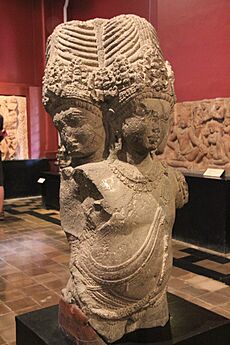
Many artworks from the Elephanta Caves are now in museums across India. These include a very damaged Durga statue. Only the buffalo demon with Durga's legs and some of her waist remain. Other studied sculptures include part of a Brahma head, several Vishnu ruins, and various carved panels. Some of these pieces were likely not from the Great Cave. It's unclear where they were found when they were moved or when the ruins were cleared.
The significant Vishnu statues are hard to explain. One idea is that some caves might have been for the Vaishnavism tradition (worship of Vishnu). Another idea is that the island once had Hindu temples built in the open air, not just caves. These might have been destroyed first.
The Vishnu sculptures found among the Elephanta ruins show different styles. One wears a dhoti (a traditional Indian garment) and holds a conch shell. It likely had four arms. Another statue has elements of both Shiva and Vishnu. It has a chain link near the thigh and a gada (mace). Someone stands next to it, possibly a Devi (goddess). This statue also wears a dhoti.
Old records from the 18th century mention a stone horse on the island. This was like the stone elephant that gave the island its name. But this horse was moved to an unknown place before 1764.
History of the Caves
The very old history of Elephanta Island is not well known from Hindu or Buddhist records. But archaeological studies show that people lived on the island as early as the 2nd century BCE. The island was first used by early Buddhists. They built a large stupa for the Buddha and seven smaller stupas around it. Coins from the 4th century CE were found on the island.
The Elephanta Caves were built between the 5th and 6th centuries. Most experts believe they were finished around the mid-6th century. They were built by King Krishnaraja of the Kalachuri dynasty. This dating is based on coins, inscriptions, building style, and better dating of other caves like the Ajanta Caves.
The art at Elephanta Caves was inspired by Hindu stories and ideas. These came from ancient texts like the Vedas, epics, and Puranas. The carvings show the stories and ideas that were well known to artists in India around 525 CE. The art shows how ancient religious thought influenced Hindu culture in the mid-1st millennium CE.
After the caves were finished in the 6th century, Elephanta became known as Gharapuri (village of caves). This name is still used in the local Marathi language. The island later became part of the Gujarat Sultanate. In 1534, they gave it to Portuguese merchants. The Portuguese named it "Elephanta Island" because of a huge stone elephant statue. This statue was a landmark for their boats. The elephant statue was damaged when people tried to move it to England. It was moved to the Victoria Gardens in 1864. It was put back together in 1914 and is now in the Jijamata Udyaan in Mumbai.
Experts disagree on who damaged the Elephanta Caves the most. Some say the monuments were already damaged during the Sultanate rule. Others believe the Christian Portuguese soldiers caused more damage. They say the soldiers used the caves and statues for target practice.
The Portuguese gave the island to the British in 1661. By then, the caves were already very damaged. The Portuguese had also removed and lost an inscription stone from the caves. During British rule, many Europeans visited the caves. Some called the art "enormous" and "extraordinary."
The British relied on the port city of Bombay (now Mumbai). This made it a big city. Many Hindus moved there for work. The Elephanta caves became a center for Hindu worship again. The British government even charged pilgrims a temple tax since at least 1872. In 1903, Hindus asked the government to remove this fee. The British agreed to waive it on three Shiva festival days. Otherwise, the caves were left in their ruined state.
In the late 1970s, the Indian government restored the main cave. They wanted to make it a tourist and heritage site. In 1987, the caves were named a UNESCO World Heritage Site. UNESCO said the caves "represent a masterpiece of human creative genius." They also said the caves "bear a unique or at least exceptional testimony to a cultural tradition."
Protecting the Caves
The Elephanta Caves are easy to reach from Mumbai. This made them popular for guidebooks and studies in the 20th century. Early ideas and misunderstandings about the caves led to many different interpretations. But it also increased support for protecting them. When James Burgess published their condition and sketches in 1871, it brought more attention.
The first efforts to protect the Elephanta Caves were made by British officials in 1909. The site was placed under the Indian Archaeological Department. The Ancient Monuments Preservation Act included it. This helped protect the island and its ruins.
More specific laws were made to protect the Elephanta Island monuments. These include the Ancient Monuments and Archaeological Sites and Remains Act of 1958. The Elephanta Island (Protected Monument) Rules of 1957 stop mining, quarrying, and digging near the monument. A rule in 1985 declared the entire island and a 1-kilometre (0.62 mi) area from the shore as a "prohibited area." Many other state laws also protect the site. But it was in the 1970s that the site got active conservation and restoration. These efforts rebuilt parts of Cave 1 and broken pillars in other caves. They also developed the island as a heritage site.
The Archaeological Survey of India (ASI) manages the Elephanta Caves. They monitor and stabilize the rock faces. They build supports where pillars have fallen. They also strengthen cave floors and build walls around the site. Plus, they maintain visitor facilities and a museum on site. About 1,000 visitors come each day. More come during Shiva festivals, dance festivals, World Heritage Day (April 18), and World Heritage Week (November 19-25).
After the caves were declared a World Heritage Site, UNESCO and the ASI have worked together. They monitor the site and regularly use conservation methods.
In Books and Stories
In 1834, Letitia Elizabeth Landon wrote a poem called The Caves of Elephanta. She felt sad that the caves had lost their original spiritual purpose. She wrote that the "mighty shrine" now only shows "Man's meanest attribute" (force).
The Elephanta Caves are mentioned several times in Herman Melville's famous book Moby Dick. They also appear in Somerset Maugham's 1944 novel The Razor's Edge.
See also
- Ajanta Caves
- Ellora Caves
- Indian rock-cut architecture
- List of rock-cut temples in India
- Tourism in India




